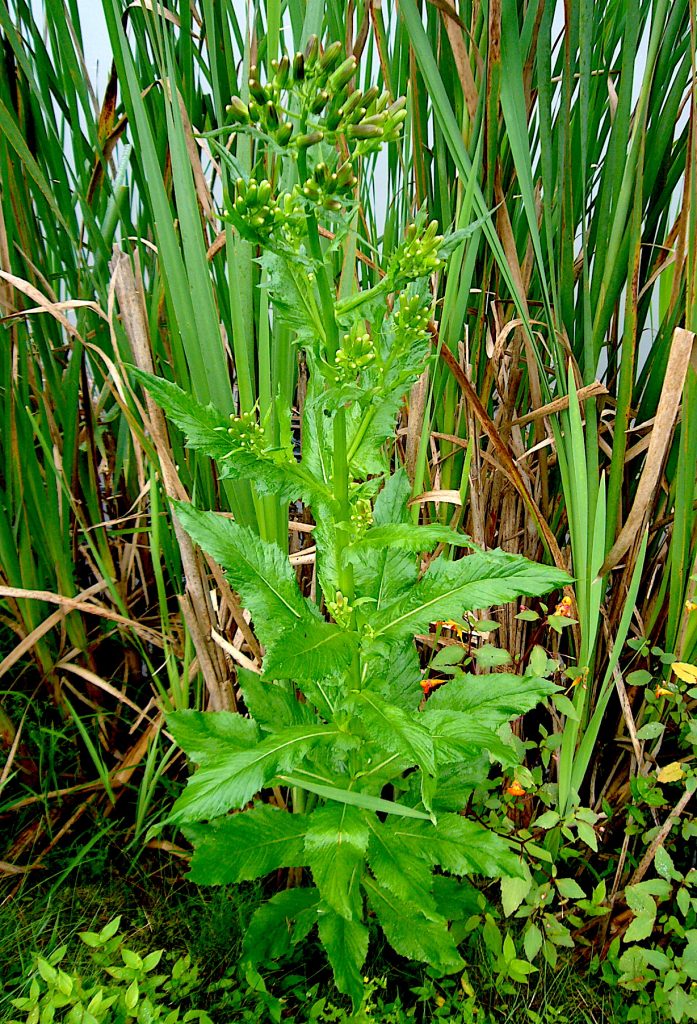
Burnweed/Fireweed in blossom in front of cattails. Photo by Green Deane
Fireweed/Burnweed has a flavor chefs love. With an impossible scientific name and strong aroma Fireweed is often over looked by the foraging community. Conversely the aroma is also a good identifying characteristic. As with several things in life tastes vary and many people enjoy the Fireweed raw or cooked. Closely related to the Dandelion, the Fireweed locally favors the late winter or early spring. Currently you can find Fireweed from a few inches high to a couple of feet. While they do not grow in colonies often several will grow near each other. Soon the older ones will put on green-yellow blossoms that barely open, another identifying characteristic. Of course in greens young and tender is usually preferable and this is particularly true with the Fireweed which grows rank as it ages. To read about fireweed go here.
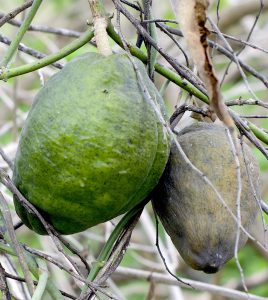
Fruit of the Latex Strangler Vine. Photo by Green Deane
Another recent find was Latex Strangler Vine. At one time a bane of the citrus industry the lengthy vine grows edible fruit that is high in vitamin C. It’s called “Strangler” because it can cover a citrus tree shading it out and killing it. The specie was “found” twice in Florida some twenty-five years apart in the last century. The state unsuccessfully spent millions trying to get rid of it Look for it on fences and around current or old citrus groves. Decades ago when the weather was warmer the vine was common wherever there was citrus. Cooler weather has frozen it and citrus out on the north end of the state. I have seen Latex Strangler Vine in Ocala and near Gainesville but that’s the limit. In both cases the plants were under Live Oaks and in unmowed areas. It is quite common mid-state and south. The blossoms are edible off the vine. The raw leaves can also be eaten but are usually dipped in oil first. My article on the species is here. I also have a video on the species here.

Classes are held rain or shine or cold. (Hurricanes are an exception.)
Foraging classes: Two favorite class locations are on tap this weekend end, Mead Garden in Winter Park and Red Bug Slough in Sarasota.
Saturday, March 6th, Red Bug Slough Preserve, 5200 Beneva Road, Sarasota, FL, 34233. 9 a.m. to noon.
Sunday, March 7th, Mead Gardens, 1500 S. Denning Dr., Winter Park, FL 32789. 9 a.m. to noon. The entrance is on the west side off Denning not the east side off Pennsylvania. Some GPS maps are wrong. Meet near the bathrooms.
Sunday, March 14th, Wickham Park, 2500 Parkway Drive, Melbourne, FL 32935-2335. 9 a.m. to noon. Meet at the “dog park” inside the park.
Saturday, March 20th, George LeStrange Preserve, 4911 Ralls Road, Fort Pierce, FL, 34981. 9 a.m. to noon. Meet in the parking lot.
Sunday, March 21st, Boulware Springs Park, 3420 SE 15th St., Gainesville, FL 32641. 9 a.m to noon, meet at the pavilion by the pump house.
For more information on these clases, to prepay or sign up go here.
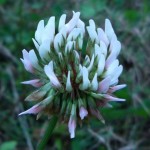
Clover prefers low nitrogen soil.
Clover is one of those wild edibles that is both overstated and understated. The overstatement is from writers who offer it as a great human food full of this and that to keep us healthy. The understated part is that it can harbor a fungus that inhibits clotting and somewhere around a half-a-cup of raw leaves can make you throw up. Individual experience, of course, can vary and there are several different species of clover with different characteristics. Pictured here is a nice little White Clover which is blossoming now mostly in lawns and athletic fields. A few leaves can be eaten raw. They are high in protein for a leaf. The blossom fresh or quickly dried can be used for tea. There is also Crimson, Red, Sweet and even Tick Clover.
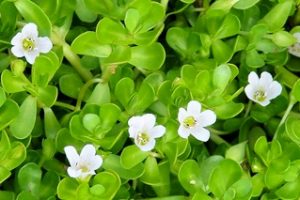
Bacopa monnieri can have four or five petals.
Before I forget it’s time to write about Bacopa again. Actually there are six Bacopas locally, two common: Water Hyssop and Lemon Bacopa. They are quite different and perhaps it takes a trained botanical eye to appreciate their similarities which strike me as few. Perhaps their greatest difference is texture. Lemon Bacopa is soft, fuzzy, and crushes easily. It smells like limes not lemons. Water Hyssop is tough and shiny, resilient. Lemon Bacopa is aromatic and fruity in flavor, Water Hyssop is just pain bitter. Water Hyssop definitely can help with memory issues, Lemon Bacopa is more iffy on that score. One does not find Lemon Bacopa too often whereas Water Hyssop is nearly everywhere the soil is wet and sunny. (There are actually five Bacopas that look like the bitter one we want but four of them are rare. The one we want, Bacopa monnieri, by far the most common, has a single crease on the back of the leaf.) I have found Lemon Bacopa only three times; two of them in the wet ruts of woods roads. There is also a lake near me that has a little growing near a boat ramp when the water level is just right. As my article speaks more towards Lemon Bacopa I will adress Water Hyssop here. It basically stimulates the brain to make new neuronal connections, specifically in the hippocampus. It is anti-inflammatory and interacts with the dopamine and serotenergic systems. As you might expect growing new memory cells enough to notice takes time. So Bacopa has to be taken daily for at least three months. I have had several people tell me it has made significant difference in their lives. It does not work on all causes of memory problems but if it does work it does so dramatically. You can read about both Bacopas here.
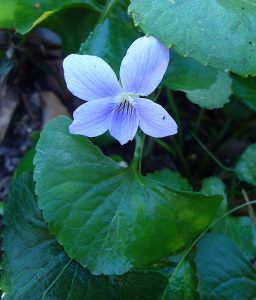
Violet Photo by Green Deane
There’s a huge variety of violets in North America ranging from Wood Violets to those that like to grow down hill from the septic tank. Its cultivated brethren is the pansy. Whether wild or cultivated violets are attractive, personable blossoms, usually on the sweet, viscous side. There are a couple of precautions, however. The first is to make sure the soil they are in — either a pot or bed — is wholesome and that the water they are getting is good. If they come from a garden center they might have pesticides on them. The other precaution is a bit more esoteric: Yellow blossoms tend to have a laxative effect. We saw these violets during out foraging class in Jacksonville this past weekend. You can read about violets here. I have a video about them here.

Green Deane videos are now available on a USB.
150-video USB or 135 video DVD set would be a good spring present and either is now $99. My nine-DVD set of 135 videos has been selling for seven years and are still available. I have one set left. They are the same videos I have on You Tube. Some people like to have a separate copy. A second option is a 16-gig USB that has those 135 videos plus 15 more. While the videos can be run from the DVDs the videos on the USB have to be copied to your computer to play. They are MP4 files. The150-video USB is $99 and the 135-video DVD set is now $99. The DVDs will be sold until they run out then will be exclusively replaced by the USB. This is a change I’ve been trying to make for several years. So if you have been wanting the 135-video DVD set order it now as the price is reduced and the supply limited. Or you can order the USB. My headache is getting my WordPress Order page changed to reflect these changes. We’ve been working on it for several months. However, if you want to order now either the USB or the DVD set make a $99 “donation” using the link at the bottom of this page or here. That order form provides me with your address, the amount — $99 — tells me it is not a donation and in the note say if you want the DVD set or the USB.

Green Deane Forum
Want to identify a plant? Perhaps you’re looking for a foraging reference? You might have a UFO, an Unidentified Flowering Object, you want identified. On the Green Deane Forum we — including Green Deane and others from around the world — chat about foraging all year. And it’s not just about warm-weather plants or just North American flora. Many nations share common weeds so there’s a lot to talk. There’s also more than weeds. The reference section has information for foraging around the world. There are also articles on food preservation, and forgotten skills from making bows to fermenting food.
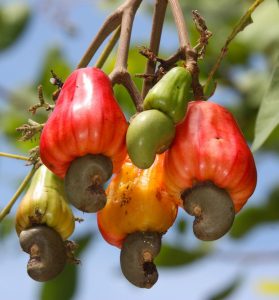
Unprocessed cashews are not edible.
One of the more strange trees is the cashew. The species is closely related to poison ivy, poison oak, poison sumac, edible sumac, mangos, and pistachios. The cashew itself is an exceptionally toxic tree. The cashew “seed” is actually an enclosed nut inside an enclosed shell. It is surrounded by a toxic sap. The sap is dangerous. The process of making the seed edible is dangerous. While the end product is a tasty nut it is among the least nutritious of tree seeds. Oddly the cashew “apple” is quite edible. Before Hurricane Irma we saw them in West Palm Beach. The storm took them out. You can read more about the cashew here.
This is weekly newsletter #447, If you want to subscribe to this free newsletter you can find the sign-up form in the menu at the top of the page.
To donate to the Green Deane Newsletter click here.


You said about the Strangler Vine, “I have seen Latex Strangler Vine in Ocala and near Gainesville but that’s the limit.” I live in St. Augustine just east of exit 318 on I-95 and I believe we have a specimen of this here. I’ve taken a few pictures of last years fruit that apparently has dropped to the ground but I don’t know how to send them to you to verify.
It should grow in St. Augustine. Send photos to GreenDeane@gmail.com
I value your opinions, I know you do not teach herbalism, but I bet you know of someone who specializes in Florida herbs & if they have classes or video or websites. Please refer me to them.
That could depend where you live in Florida.